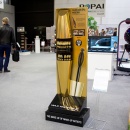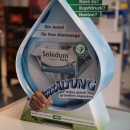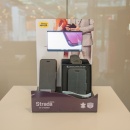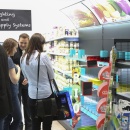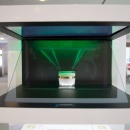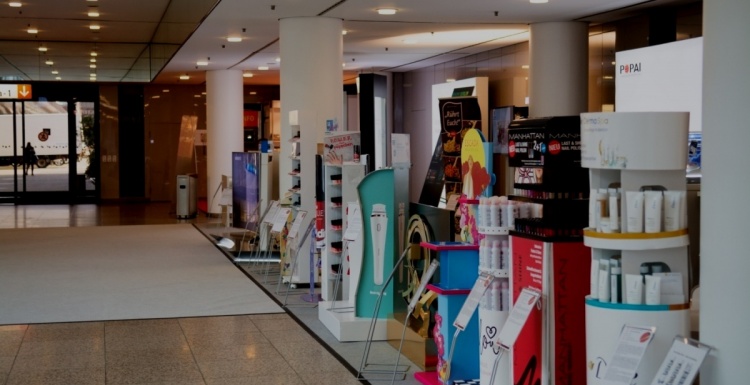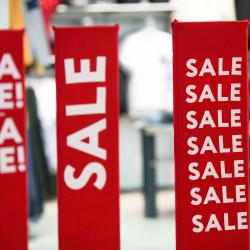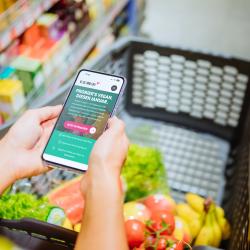Displays for the POS: from cardboard display to digital signage element
How displays are turning into key touchpoints along the customer journey
The actual decision to purchase a product or brand is often made at the POS. It takes the right means of communication to persuade consumers at this juncture. Most notably, this includes eye-catching brand communication. That’s why the retail industry frequently uses displays – also affectionately called “traffic stoppers” – to showcase small or seasonal items.
Between 70 and 80 percent of all purchase decisions are made impulsively at the POS. This is also why it’s no longer just manufacturers of brand-name products but also retailers and their own brand labels that are vying for the so-called “first moment of truth“ – the moment that describes the crucial seconds during which a customer decides to purchase a specific product or brand. Especially when it comes to product categories that are typically purchased on impulse, displays manage to generate the required attention to spark the interest of customers and invite them to buy.
According to studies, the “first moment of truth“ can be multiplied by combining a POS display with a price promotion.
Different types of displays for different scenarios and applications
The first characteristic of displays is that they are only displayed for a limited amount of time. Short-term displays only remain a few short weeks or days at the POS. Retailers in Germany prefer to use pallet displays for temporary sales promotions because they are generally set up on quarter pallets and are therefore easy to move. Another advantage of this type of display is that it is primarily being delivered to retailers in a fully stocked and ready-to-go state. This makes handling a lot easier. What’s more, deliberate empty spaces in the product displays and a color-matching scheme also increase sales.
Unlike pallet displays, floor displays are assembled right at the POS because they are often too heavy to be easily moved around. They are ideal for smaller spaces. However, once assembled, they should not exceed 15 kilograms since this is the maximum weight sales staff is allowed to lift or carry. Floor displays are very popular in Europe because aside from their use in retail stores, they are also being utilized in gas stations, drug stores and convenience stores. Floor displays are considered long-term or permanent displays because they remain at the store for more than a year in some instances and are regularly restocked by employees.
In addition to the already mentioned free stand and self-supporting product display types, there are also smaller types of displays used to complement merchandise. When retailers only have a limited amount of space, PDQ and in-shelf displays are a great choice to set individual items apart from competing brands. So-called parasite units are also positioned in or on the shelf. They frequently combine complementary products such as chips and beer to encourage the purchase of complementary goods. Counter displays are also a sensible choice in areas with a focus on personal customer service, like the checkout counter for example. They boost impulse buys because they cater to customers right at the last moment before they pay. This display is not just suited for seasonal product samples or free samples but also for informative content such as brochures or sweepstakes to enhance a sales campaign.
The form varies greatly depending on the requirements pertaining to country, product segment and product. According to country prerequisites, brand manufacturers should therefore closely examine retailer requirements that are relevant to the design of the display ahead of time.
Boosting display design with new technologies
When we think of displays, we often associate pure cardboard displays. This is especially true when it comes to short-term displays. They are often made of a mix of cardboard and paper that is covered with printed cardboard. Meanwhile, long-term displays feature attention-getting characteristics such as illumination and motion effects to motivate customers. The use of materials such as wood or metal is also quite common. The side and base paneling design and striking header also catch the attention of consumers.

In the Age of Digitization, digital signage solutions are increasingly being integrated to promote an interaction between display and customers. Right now, the most popular example of this is the digital Maggi Recipe Finder, which was designed for Nestlé in collaboration with PEGO GmbH and gekartel AG. In addition to a variety of Maggi fix&frisch products, the center of the display features a touchscreen with animations and product recommendations. Customers can print out recipes right on the spot. Contents are centrally managed by Maggi via data communications. Retailers only have to stock the display with the respective products.

Read more on sales promotion using displays:
The so-called Hypebox is a unique in-shelf solution. Due to its size, it can be optimally integrated into a shelf. The Mars GmbH recently positioned a box at the Edeka Center Berlin Moabit to showcase the Pedigree product selection. Not only are customers able to check out the products inside the box, they can also call up information about individual products by touching the display. The products are then embedded, illuminated and thus perfectly staged via the transparent display of the box.
That being said, the evolution of displays is far from being complete. Beacons are yet another exciting topic because they are able to directly communicate with the customer’s smartphone to draw attention to specific products. Together with Mondelēz, real- and Payback, Chep is already in the process of testing a quarter pallet with an integrated beacon. As soon as Payback app users approach the display, they receive a push notification to their cell phone offering a sales discount for the advertised Mondelēz item. Target communication with customers at the POS is not the only objective in this case but also the optimization of product availability by analyzing the supply chain as a whole. This lets retailers capture whether and where a pallet is located on the sales floor or whether it is still in the warehouse of the supermarket.
The integration of facial recognition tools is also a discussion point in display design.

Added benefit for the customer journey
Thanks to an attractive design and well-thought-out placement, displays are able to attract the attention of customers and thus boost impulse buys. But before you choose one of the many display types, you should first pinpoint the added benefits that digital technologies, in particular, offer customers. This is the only way to draw the attention to the display and turn it into a key touchpoint along the customer journey.
channels: displays, sales promotion, display fittings, promotions, display stands

